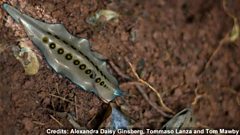Mutations in Nature
How change happens in the natural world, on the molecular level. Biologist Andreas Wagner, plant geneticist Zachary Lippman and designer Alexandra Daisy Ginsberg discuss.
How did the leopard get its spots? And why is it that no matter what drugs clever scientists devise to fight diseases like malaria and tuberculosis, new resistant strains still emerge? This week we are talking about mutations in nature, the way all living things evolve to adapt to their environment. How exactly does the process work? With evolutionary biologist Andreas Wagner, plant geneticist Zachary Lippman and designer Alexandra Daisy Ginsberg.
(Photo: The Snow Leopard. Credit: Getty Images)
Last on
Clip
-
![]()
Could synthetic organisms help us save nature?
Duration: 01:42
Chapters
-
Andreas Wagner
Unlocking the secret of mutations
Duration: 10:21
Zachary Lippman
Improving the tomato
Duration: 10:56
60 Second Idea
Should some ‘failed’ ideas be revived?
Duration: 06:08
Alexandra Daisy Ginsberg
Reimagining nature through design
Duration: 10:57
Andreas Wagner
![Andreas Wagner]()
Andreas Wagner is a professor in the Institute of Evolutionary Biology and Environmental Studies at the University of Zurich, Switzerland, and external professor at the Santa Fe Institute. Wagner Lab’s uses powerful computers to map how trillions of possible mutations occur, and how it is that an organism finds the one it needs. He says that for every new environmental change that requires a mutation in an organism’s metabolism or genome, say, a new source of food, there is a ‘hyperastronomical’ number of possible mutations capable of exploiting the new circumstances while keeping the organism alive.
Zachary Lippman
![Zachary Lippman]()
Associate professor Zachary Lippman leads the Lippman lab at the Cold Spring Harbor Laboratory, New York, exploring how mutations in regulators of the flowering transition in crop plants, such as the tomato, can be exploited to improve crop productivity. He says that despite hundreds of years of traditional cross-breeding, variants that can maximize crop yields may not exist in natural populations. He has found that tomato productivity can be optimised by mutating the genes which control the balance between vegetative growth and flowering.
Alexandra Daisy Ginsberg
![Alexandra Daisy Ginsberg]()
Alexandra Daisy Ginsberg is a designer, artist and writer. She works as design fellow on Synthetic Aesthetics, Stanford University/University of Edinburgh, and is developing experimental design approaches to help us imagine alternative ideals around technology. For instance, what might happen if we engineer entirely new forms of life through synthetic biology, based on, say, six-base, ‘orthogonal’ DNA, rather than on the conventional four-base one.
Photo: Harry Borden60 Second Idea to Change the World
![60 Second Idea to Change the World]()
Are new ideas always the sure way to a better future? Alexandra Daisy Ginsberg says that sometimes, instead of coming up with new ideas, we should sift through old ideas, the things that went wrong, that did not take off first time around, to see if we have missed something. Perhaps the timing was wrong or the context meant the idea did not survive. In addition to documenting the things that worked, we should have encyclopaedias of bad ideas, to see how we might improve on them, and to make sure we do not repeat the same mistakes again.
Broadcasts
- Mon 24 Nov 2014 03:05GMT����ý World Service Online
- Tue 25 Nov 2014 09:05GMT����ý World Service Online
What is the role of libraries in the digital age?
Podcast
-
![]()
The Forum
The programme that explains the present by exploring the past








